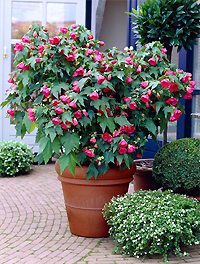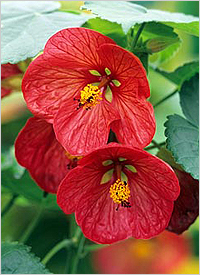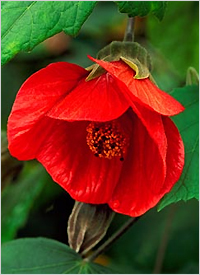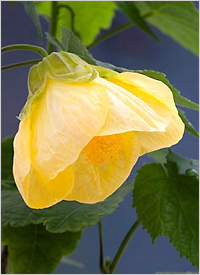Abutilon, Flowering Maple

Abutilon (Abutilon), or indoor maple, belongs to the Malvaceae family, just like the popular houseplant hibiscus. The Abutilon genus includes about 150 species of annual and perennial herbs, shrubs, or small trees. It is distributed throughout the tropics and subtropics of the Americas, Africa, Asia, and Australia. General common names include Indian mallow and velvetleaf; ornamental varieties may be known as room maple, parlor maple, or flowering maple.
These indoor flowers are valued for their long flowering period and undemanding nature. If there is enough light, it can bloom all year round. In typical home conditions, abutilon blooms from April to November. The bell-shaped flowers come in various colors, including white, yellow, red, burgundy, and even purple. Abutilon leaves resemble maple leaves, large, 3-5 lobed, with graceful incisions; in color, they are green or variegated with white spots. Large leaf plates release a lot of moisture, allowing for increased humidity and improved microclimate in the room.


Several types of abutilons are cultivated as indoor plants. Among flower enthusiasts, the most widespread is the hybrid abutilon (Abutilon x hybridum), created by crossing several natural species. Their features include:
- Compact size, especially valued for growing abutilons indoors;
- Strong branching of the bush;
- Diversity of leaf shapes and shades;
- Abundant flowering;
- Large flower size;
- A wide variety of flower shades - abutilon varieties with white, red, yellow, and orange flowers, solid-colored and two-toned, with brighter veins, and double petals.
Hybrid forms typically have a more extended flowering period. The indoor maple grows quickly, branches well, and during the spring-summer period, a small tree or compact bush can be formed from a cutting.
Abutilons are used to greenify rooms, winter gardens, and offices. They do not require complicated care, making them quite undemanding houseplants. In summer, they can be used outdoors to decorate terraces and inner courtyards. Thanks to their ability to quickly spread and bloom within 2 months of planting cuttings, abutilons are excellent for summer greening of verandas, balconies, and other spaces suitable for flower cultivation only in warm weather. A single overwintered parent plant in an apartment can produce many cuttings that will rapidly transform into beautiful blooming trees and bushes.


How to Grow and Care for Abutilon
Light. The indoor maple loves light and requires good lighting both in winter and summer. It tends not to bloom and its stems stretch out in insufficient light. With adequate light, there are usually no problems with growing abutilons. Southern windows are ideal in winter and autumn, but bright summer sunlight can damage the delicate shoots, so it's best to shield the plant from direct sunlight.
During summer, the indoor maple can be placed on a wind-protected balcony or in the garden.
Temperature. In summer, the optimal temperature for abutilon is between 22-25°C, and in winter, it should be kept between 12-15°C. If the temperature drops lower, the plant may shed its leaves. This inconvenience can also occur due to cold drafts.
Air humidity. Abutilons are not too demanding when it comes to air humidity, but in warm and dry indoor conditions during winter, leaves may dry out and curl. Periodic spraying or the use of air humidifiers can be beneficial..
Water. During the summer growth period, let the soil dry to 1 inch (2.5 cm) between waterings, then give adequate water until it runs through the pot. In the winter, reduce the watering to monthly. It also helps to mist plants weekly or so throughout the winter to prevent pest infections. Overwatering and substrate drying can cause abutilons to react by losing their leaves. .
Soil. A rich, peat-based potting soil with excellent drainage is beneficial. A mixture of loam, humus, leaf soil, and sand is suitable, or a ready-made substrate for palms can be used. .
Fertilizer. From spring to autumn, feed every two weeks with fertilizers for flowering plants. Reduce or stop fertilizer entirely in the winter.
Repotting Young plants should be transplanted annually in spring, while adults can be transplanted every 2-3 years. The new pot size should not be much larger than the previous one, as abutilon will grow roots extensively in a large pot, delaying flowering.
Pruning. Abutilon is a relatively fast-growing plant, especially when they're young. In autumn or early spring, trim the shoots by half. If not pruned, the indoor maple can grow up to 1.5 meters in height in one season. During the growing season, it's recommended to trim weak shoots.
By leaving one vertical stem and removing all lateral shoots up to a certain height, you can easily create a tree. Early pinching of the cutting's tip enhances the bushiness of the plant.
Propagation. Propagating abutilons is not difficult, usually done through cuttings. Varieties with green leaves can be propagated by seeds and cuttings; variegated varieties are propagated only by cuttings.
Seeds are sown in early spring (March-April) in a light substrate and placed in a mini-greenhouse. They germinate at temperatures of 22–28°C, sometimes in 20 days, and occasionally up to three months. They begin flowering about 3.5 months after germination. Seedlings grow quickly, so they are transplanted into larger pots 2-3 times during the summer.
Cuttings are 10-12 cm long with three leaves, and buds are pinched off. They can be rooted in perlite, sand, any light substrate, or in water. Roots usually appear in about two weeks.
Diseases and pests. Abutilons are often affected by aphids, whiteflies, spider mites, mealybugs, and scale insects, which are attracted to the plant's attractiveness. Chemical preparations can be used to combat them. Insecticides for indoor plants are sold in every flower shop and should be applied according to the instructions. Indoor plants thrive in a more humid environment, so this should also be taken into account.
Possible care problems for abutilon are usually indicated by issues with the leaves:
- Falling off: Sudden temperature changes, drafts, over-drying, or over-moistening of the soil.
- Dry brown tips: Too dry air in the room or insufficient watering.
- Wilting: Soil drying out.
- Yellowing, followed by falling off: High temperature or dry air.
- Stems stretching, leaves becoming pale and dull: Lack of light.
- Curling leaf edges, dried-up tips: Too bright light and dry air.
- Yellowing with spots: Lack of nutrients in the soil.




